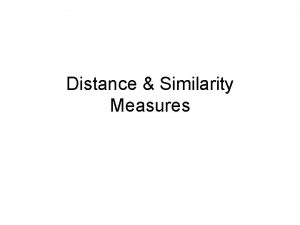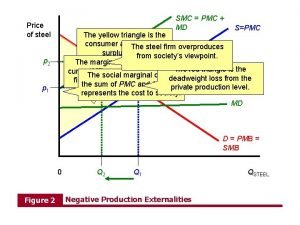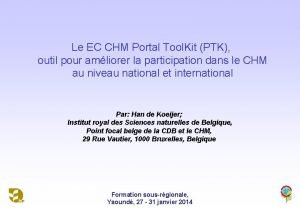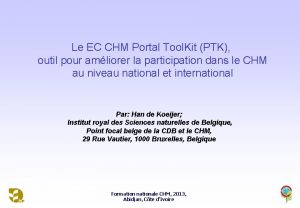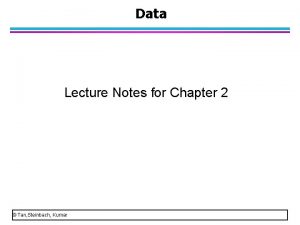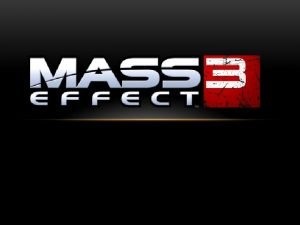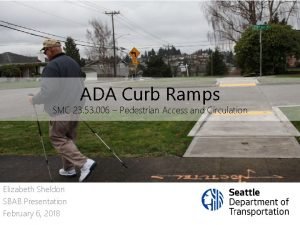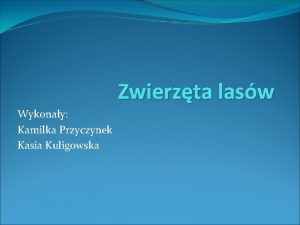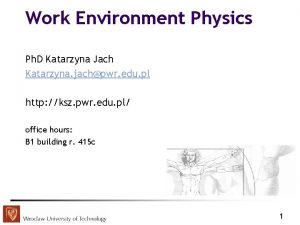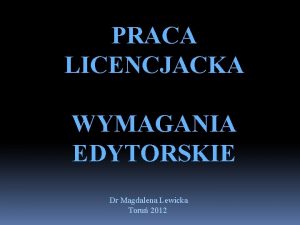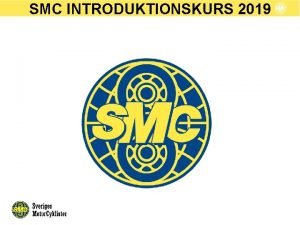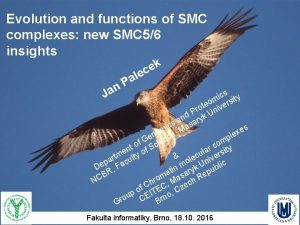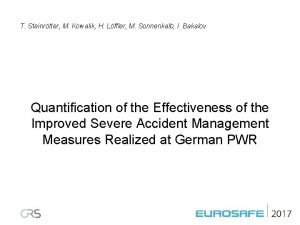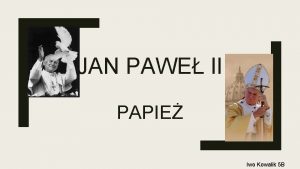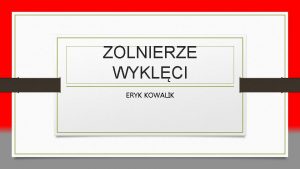SMC analysis of highp T events Katarzyna Kowalik



















- Slides: 19

SMC analysis of high-p. T events Katarzyna Kowalik Sołtan Institute for Nuclear Studies Warsaw, Poland DIS 2004, 14 -18/04/04 Štrbskė Pleso, Slovakia

PGF with high-p. T hadrons Photon Gluon Fusion (PGF) Leading Process (LP) QCD Compton (QCD-C) Pairs of high-p. T hadrons more likely in QCD-C and PGF Katarzyna Kowalik DIS 2004, 14 -18/04/04 2

G/G from measured asymmetry Al. N lhh. X PGF LP QCD-C taken from inclusive DIS measurements the asymmetry for hard sub-process R the fraction of events Katarzyna Kowalik DIS 2004, 14 -18/04/04 Provided by Monte. Carlo 3

G/G determination for production of pairs of hadrons with high-p. T • Idea proposed by R. D. Carlitz, J. C. Collins and A. H. Mueller, Phys. Lett. B 214, 229 (1988) • Revisited by A. Bravar, D. von Harrach and A. Kotzinian, Phys. Lett. B 421, 349 (1998) • Method used in HERMES for photoproduction HERMES, A. Airapetian et al. , Phys. Rev. Lett. 84, 2584 (2000) xg=0. 17 • Here application for DIS region, SMC data with Q 2 >1 Ge. V 2 SMC, B. Adeva et al. . , submitted to Phys. Rev. D, hep-ex/0402010 Katarzyna Kowalik DIS 2004, 14 -18/04/04 4

Beam: µ+ 190 Ge. V Pµ= -0. 78± 0. 03 Target: butanol, ammonia d-butanol Proton Deuteron PTp ~ 0. 89 PTd ~ 0. 50 Katarzyna Kowalik DIS 2004, 14 -18/04/04 5

Data sample for asymmetry calculation Full SMC statistics with longitudinal target polarization was used • µ µ ‘ and at least 2 hadrons at primary vertex Q 2 [Ge. V 2] • Kinematic cuts : Q 2 1 Ge. V 2 p. QCD region y 0. 4 • y<0. 9 9. 0 < y for both hadrons with p. T 0. 7 Ge. V : 4 . 0 > y x. F 0. 1, z 0. 1 x Statistics after selection: proton ~81 K , deuteron ~75 K below 0. 5% of the inclusive sample Katarzyna Kowalik DIS 2004, 14 -18/04/04 6

Monte Carlo studies → studies for DIS µN interactions for EB=190 Ge. V → LEPTO simulations, Q 2 1 Ge. V 2 → detector and reconstruction effects • • • simulations of trigger conditions geometrical acceptance for hadrons, muons looses in reconstruction (chamber efficiencies) smearing for scattered µ and hadrons (1/p, angles) secondary interaction in target for hadrons Important consistency between data and Monte Carlo Katarzyna Kowalik DIS 2004, 14 -18/04/04 7

Data Number of events MC Kinematic variables Data/MC Number of events Data/MC Katarzyna Kowalik DIS 2004, 14 -18/04/04 8

Data Hadron variables MC Data and Monte Carlo agree at the level of 10 -25% To be used for selections of PGF and ∆G evaluation Katarzyna Kowalik DIS 2004, 14 -18/04/04 9

Contribution of PGF process • generated sample LP=73% QCD-C=19% PGF= 8% • 2 hadrons with p. T 0. 7 Ge. V LP=40% QCD-C=35% PGF=25% Two methods to enhance PGF contribution used cut selections and neural network classificattion (NN) Criteria to judge the selection: Katarzyna Kowalik DIS 2004, 14 -18/04/04 10

Several variables were considered to find the optimal selection: • various cuts on p. T of both hadrons • oppositely charge hadrons 1% better purity but loss of statistics ~30%, • invariant mass of the pairs of hadrons, • difference between azimuthal angle of hadrons do not improve purity Purity [%] For the analysis (p. T 12+ p. T 2 2) > 2. 5 Ge. V 2 Purity ~31% at efficiency ~30% 1 2 3 4 p. T 12+ p. T 22 Katarzyna Kowalik DIS 2004, 14 -18/04/04 11

Neural network Motivation: optimal use of many correlated variables The optimal set of input variables (input layer): event kinematics (x, y, Q 2) and hadron variables (E 1, 2, p. T 1, 2, charge, azimuthal angle between p. T of two selected hadrons) NN response • output layer: single unit number within range (0, 1) interpretation in terms of background and signal contributions Katarzyna Kowalik DIS 2004, 14 -18/04/04 12

Neural Network response LP QCD-C PGF number within range <0, 1. > events at high values of NN response are more likely to be PGF enriched sample selected by setting the threshold on the NN response Katarzyna Kowalik DIS 2004, 14 -18/04/04 13

The result of cut selection based on (p. T 12+ p. T 2 2) compared to NN For NN purity is growing with efficiency in full range → NN response > 0. 26 (purity ~33% at efficiency ~56% ) Katarzyna Kowalik DIS 2004, 14 -18/04/04 14

Results on Asymmetry Al. N lhh. X p. T 0. 7 Ge. V Selectio n p. T 2 2. 5 Ge. V 2 Proton Al. N lhh. X Q 2 NN 0. 26 Deuteron 0. 018 0. 071 0. 01 7. 1 0 Al. N lhh. X Q 2 0. 054 0. 093 0. 008 7. 9 of A l. N→ lhh. X in terms ∆G/G requires additional NNInterpretation 0. 030 0. 057 0. 01 3. 3 of 0. 070 4. 0 information from MC simulation. 0 0. 077 0. 010 Katarzyna Kowalik DIS 2004, 14 -18/04/04 15

Inputs to G/G calculations From other measurements: A 1 asymmetry taken from fit to data From MC simulations: • partonic asymmetries a. LL LP 0. 8 a. LL QCD-C 0. 6 a. LL PGF -0. 4 • fractions of processes in the selected sample Selection RLP RQCD-C RPGF p. T 2 2. 5 Ge. V 2 26% 43% 31% NN 0. 26 37% DIS 2004, 30% 33% Katarzyna Kowalik 14 -18/04/04 16

Gluon polarization ∆G/G determined for a given fraction of nucleon momentum carried by gluons xg Averaged over proton and deuteron: Selection p. T 2 2. 5 Ge. V 2 NN 0. 26 Katarzyna Kowalik G/G ( G/G)stat -0. 07 0. 40 -0. 20 0. 28 DIS 2004, 14 -18/04/04 xg gen. PGF 0. 09 0. 07 17

Systematic uncertainty on ∆G/G Error source uncertainty on ∆G/G Precision of A 1 fit 0. 026 Scale change Q 2/2 ; 2 Q 2 0. 010 Fragmentation function 0. 034 Cutoffs in matrix elements 0. 008 Syst. error from Al. N→lhh. X 0. 062 Total 0. 105 The maximum observed deviation of R or a. LL +20%R / -20%R 0. 067 / 0. 100 +4% a. LL / -4% a. LL 0. 015 / 0. 017 Katarzyna Kowalik DIS 2004, 14 -18/04/04 18

Summary • ∆G/G was evaluated from the measured asymmetry for events with high-p. T hadrons collected by SMC in DIS region • Results obtained for cut selection and neural network ∆G/G stat. sys. -0. 07 ± 0. 40 ± 0. 12 cut ∑p. T 2 -0. 20 0. 28 0. 10 NN point to rather small value of the gluon polarization precision of ∆G/G limited by the statistical error • Improvement on accuracy of ∆G/G in the future: COMPASS at CERN, RHIC at BNL Katarzyna Kowalik DIS 2004, 14 -18/04/04 19
 Pitn hib
Pitn hib Gabriela borejko
Gabriela borejko Smc tool
Smc tool Smc scholars classes
Smc scholars classes Smc
Smc Andromeda smc
Andromeda smc Similarity and dissimilarity measures in data mining
Similarity and dissimilarity measures in data mining Smc technology sdn bhd
Smc technology sdn bhd Smc pmc
Smc pmc Smc house marking
Smc house marking Smc ptk
Smc ptk Smc students with disabilities
Smc students with disabilities Chm tool
Chm tool Smc vs jaccard
Smc vs jaccard Smc canvs
Smc canvs Smc 23
Smc 23 Mutually exclusive events vs not mutually exclusive events
Mutually exclusive events vs not mutually exclusive events Katarzyna sarna
Katarzyna sarna Ergonomicsl
Ergonomicsl Praca toru��
Praca toru��






